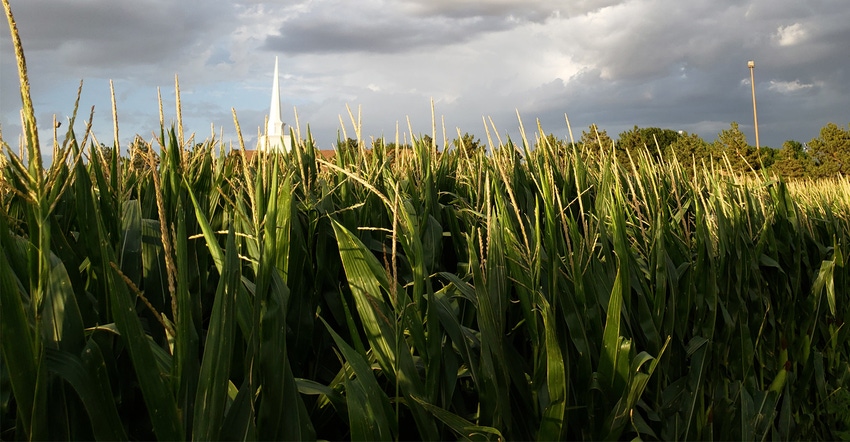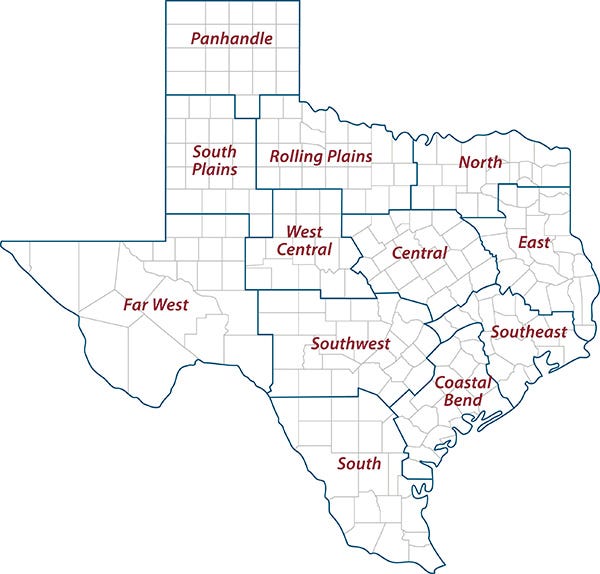
Row crops in North Texas and the South Plains are in the home stretch and Texas A&M AgriLife Extension Service experts want producers to keep a watchful eye on pest infestations.
Dr. Allen Knutson, AgriLife Extension entomologist, Dallas, and Blayne Reed, AgriLife Extension integrated pest management specialist, Hale County, reported pest activity in North Texas and the South Plains has been “light” so far. But both said producers should scout vigilantly and be prepared to act to protect crops.
CORN
Knutson said corn between Waco and the Red River is drying down, which reduces the risk of insect damage. He said harvest should begin in a few weeks.
“There have been relatively few insect problems in corn,” he said. “Mexican corn rootworms were present in some fields earlier, and spider mites bear watching in later-planted fields.”
Reed said most corn in the South Plains varied in stages due to numerous replants. But the pest pressure was also light in cornfields, with sparse fall armyworm feeding and light bollworm egg lays compared to recent seasons.
SORGHUM
Knutson said much of the sorghum crop in North Texas has completed flowering and is in the grain fill stage.
Headworms, stinkbugs and sugarcane aphids are pests of concern for the crop.
He attributed the light sugarcane aphid pressure to area growers planting aphid-tolerant sorghum hybrids. Planting these hybrids in South Texas also helped reduce the number of aphids moving into North Texas.
“Sugarcane aphids have been generally light throughout the area but can increase rapidly even late in the season,” he said. “Producers should monitor fields twice a week for sugarcane aphids and honeydew accumulation on leaves and grain heads, which can make harvest very difficult.”
For control of sugarcane aphid late season, follow insecticide labels on waiting period after insecticide application and before harvest; some have a 14-day waiting period, Knutson said.
Reed said pest populations remain light with no reports of sugarcane aphids, but producers need to be vigilant.
“This could be a long season for watching pests such as sorghum midge and many others with such a wide range of blooming time frames in the same area,” he said. “It could prove likely that the pest populations could build larger with each ‘generation’ of crop development, reaching levels that would be quite high by the fall for the latest fields.”
COTTON
The key pest of concern in cotton is the bollworm, Knutson said.
Beneficial insects that feed on bollworms are the first line of defense but can be overwhelmed when large numbers of bollworm eggs occur.
“All cotton, especially varieties with two Bt genes for resistance, should be scouted weekly for bollworms to determine if an insecticide is needed,” he said.
Reed said South Plains cotton ranged from pinhead square to first bloom. Most fields were experiencing pests, especially fleahoppers, but beneficial insects and weather conditions have decreased their numbers.
“We did find one bollworm egg in a cotton field this week,” he said. “This is early for the region and is hopefully not a precursor for issues to come, but it is noteworthy.”
HAY and PASTURES
Fall armyworm activity has been very light, with only a few reports from East Texas to date, Knutson said. Hay producers should also be mindful to watch for signs of Bermuda grass stem maggots.
The number of fall armyworms captured in pheromone traps in North Texas has also been very low. This is good news given the extensive losses observed last year.
“Fall armyworm is not believed to overwinter in North Texas so the new moths for 2019 must migrate into North Texas from overwintering in South Texas,” he said. “Trap data indicates that so far, few moths have moved into North Texas. However, risk for fall armyworm infestations increases in August and September, so weekly field inspection for fall armyworm is advised.”
AgriLife Extension district reporters compiled the following summaries:

CENTRAL: Conditions dried out due to lack of rain. Crops were starting to mature with hot temperatures. Producers were baling hay, but production slowed and pastures were beginning to stress due to the hot temperatures. All livestock were doing well on pastures. Fly numbers increased in cow herds. Nearly all counties reported good soil moisture levels. Overall crop, rangeland and pasture conditions were good in nearly all counties.
ROLLING PLAINS: Conditions were hot, dry and windy. Pastures remained in good condition. Hay production was good in grasses, sorghum and Sudangrass fields. Area sheep and cattle producers were able to rely on grazing in pastures due to good rains throughout the summer. Some sheep producers were addressing a small problem with coccidiosis, but it was under control.
COASTAL BEND: Hot, dry and humid weather conditions continued. Weather was ideal for harvesting crops. Grain sorghum and corn were drying down, with harvest in full swing in some areas and near completion in the southern end of the district. Above-average yields were reported for both corn and grain sorghum. Harvest aids were applied to some early planted cotton with first harvest about two weeks away. Other cotton fields needed a timely rain, and producers with irrigation were watering. Rice was heading out. Pastures and hayfields needed rain. Hay baling continued with average to above-average yields. Livestock were in good condition with ample forage supplies. Water levels in some stock ponds were beginning to decline.
EAST: There was little to no rain across the district. A few counties needed rainfall. Trinity County reported producers were worried about the lack of rain. Hay production was in full swing with drier conditions helping the curing process. Pasture and rangeland conditions were good in most areas. Subsoil and topsoil conditions continued to be adequate. Watermelon harvesting continued. Pea crops were fair to good. Farmers’ market sales were up. Livestock were doing well. Horn flies were a problem in Anderson County. Wild pigs caused damage across the district. Houston County reported increased armyworms and Bermuda stem maggots. Producers in several counties were keeping an eye out for armyworms.
SOUTH PLAINS: Conditions were hot and dry. Topsoil and subsoil moisture levels were fair, but the recent 100-degree temperatures were starting to dry soils out. Producers continued to irrigate. Dryland crops and pastures were struggling in the heat with no moisture. Temperatures were expected to cool, and rain was in the extended forecast. Cattle were in good condition.
PANHANDLE: Conditions were hot and dry with triple-digit high temperatures. Crop conditions were mixed around the district. Wheat farmers finally finished harvest. Corn sorghum and soybeans were growing rapidly with heat and available moisture. Weed control and plowing were taking place in crops and fallow fields. Some irrigated producers were watering corn. Rangeland and pastures were still in excellent condition. Cattle and crops have suffered from the heat. The eastern portion of the Panhandle received some much-needed moisture, but the heat rapidly dried out rangeland conditions. Western parts of the district reported adequate subsoil moisture.
NORTH: Soil moisture was short to adequate across the district. There was no rain with daytime temperatures in the mid- to high-90s and consistent 5-12 mph winds. Topsoil was drying out. Hay producers were putting up a lot of hay, with reports of some very high tonnage. However, the quality was not expected to be very good. Corn, soybeans and cotton were doing well. Potential corn yields looked very good on acres that were planted. Timely rains would help crops and pastures. Livestock were in good condition.
FAR WEST: Temperatures were around 100 degrees with lows in the upper 70s. Scattered thunderstorms produced up to 1 inch of rainfall in some areas. Lightning and high winds caused downed power lines, creating a few small fires in dried-out rangeland areas. Dryland cotton was beginning to stress in the heat. Sorghum and corn were nearing maturity or were mature in most fields. Watermelon harvest continued but also looked to be nearing the end. Grasses were dying off and pasture conditions were declining. Livestock conditions remained good to fair. Producers weaned calves and were feeding in preparation for shipping to feedlots.
WEST CENTRAL: Conditions were hot and dry. Heat stress was beginning to show in many crops, rangelands and pastures. Cotton was mostly in good condition. Grain sorghum was maturing. Forage sorghums and other hay crops continued to be harvested with decent yields due to early season rains. Rangeland and pasture conditions were declining. Grasshopper outbreaks continued in some counties, with losses to crops and forages reported. The calf and cattle market was steady on all classes.
SOUTHEAST: Scattered showers and mild temperatures were reported. But extreme hot temperatures in other parts of the district were causing pastures to dry up fast. Hay harvest was in full swing across most of the district. Vegetables were declining in production and quality. The emergence of several fungal pathogens in trees was a big issue for homeowners. Rangeland and pasture ratings were excellent to good with good being most common. Soil moisture levels ranged from adequate to short with adequate being most common.
SOUTHWEST: Hot, dry weather caused rangeland and pasture conditions to decline. Corn was drying out. Milo harvest was expected to start soon. Cotton was blooming. Livestock and wildlife were doing well.
SOUTH: Hot, dry weather conditions with short to very short soil moisture levels were reported. Maverick, Dimmit and Duval counties reported temperatures were in the 100s every day. Producers in the northeast part of Zapata County reported up to 1 inch of rain. Peanuts were pegging and under irrigation. Cotton was flowering. Cotton in Jim Wells County was showing signs of cutting out early and will most likely not produce a good yield. Cotton under irrigation looked good. Pastures were declining, and rain will be needed to produce another cutting. Forage was still adequate in most parts of the district, but grasses were drying. Some producers were hauling hay and water and providing supplemental range cubes. Some cattle producers were reducing their herds due to dry weather. Starr County reported some rangelands and pastures were responding well to recent rains. Corn was drying down well, and the harvest was in full swing. Sorghum harvest was about 10-12 days out in some parts. Bermuda grass and haygrazer was cut and baled. Irrigated vegetables and Bermuda grass fields were in good condition. Pecan orchards were developing well with irrigation.
Source: is AgriLife TODAY, which is solely responsible for the information provided and is wholly owned by the source. Informa Business Media and all its subsidiaries are not responsible for any of the content contained in this information asset.
About the Author(s)
You May Also Like




